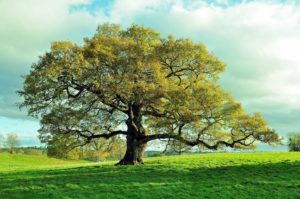
Did you know that trees have a heartbeat? An April 2018 IFL Science report discussed findings by Aarhus University researcher Dr. András Zlinszky, explaining that each arbor pumps water to circulate through its tissues, much like your heart pumps blood throughout your body. With their lifegiving sustenance through food and oxygen, their ability to house other creatures, and their creation of entire ecosystems, it’s no wonder that cultures like the ancient Celts and Norse considered them sacred. Examining their traditions and writings helps us understand how sacred trees played a significant part in their religions.
Worship and Rituals in Sacred Groves
Many civilizations viewed certain orchards, groves, and gardens of trees with reverence. A quick survey turns up several instances such as the Garden of the Hesperides in Greek lore or the Garden of Eden mentioned in the Hebrew Tanakh. For Celtic and old Norse peoples, sacred groves were often woods deemed to possess spiritual significance, usually treated as temples or worship sites. Histories penned by Adam of Bremen document a forest in which sacrifices were offered near the Temple at Upsala in Sweden, and other writings mention a Gallic goddess named Nemetona guarding sacred groves.
Druids, Trees, and Reincarnation
Druids can evoke a sense of mystery, awe, or fear depending on what you’ve heard or read about them. They served in several kinds of critical leadership and support roles within Celtic cultures:
- Teachers
- Clerics
- Legal experts
- Healers
- Political advisors
- Judges
- Historians
The Encyclopedia Britannica points out that the word “druid” may translate to “knowing the oak tree.” The Order of Bards, Ovates and Druids also explains that oaks were prized for fuel, food and construction materials and references writings by Pliny the Elder mentioning that druids typically performed their rites in oak groves. Moreover, author Philip Carr-Gomm divulges a modern Druid belief that people themselves can be reincarnated as trees in his book “What Do Druids Believe.”
Sacred Trees in Germanic and Norse Paganism
Sacred trees make additional appearances in Germanic and Norse legends. You might already know about Yggdrasil, the mythical tree said to connect the Nine Worlds of Norse mythology. According to writings in the Poetic Edda, it’s also the same one on which Odin hung himself while stabbed with his spear. On his website Norse Mythology for Smart People, blogger Daniel McCoy refers to passages of “Hávamál” in the Edda that depict Odin dangling in an altered state between life and death for nine days, staring into the water below the tree until he learned the secret of the runes.
Meanwhile, other religious artifacts may prove more links between trees and the Germanic gods. Irminsul, described as a pillar or tree trunk located in Lower Saxony, was said to be dedicated to an old Saxon god. Alternatively, “Irmin” could have been a different moniker for Odin himself. Either way, it was destroyed by the Frankish king Charlemagne during his campaign to take the Saxony region during the eighth century C.E. A Medievalists.net essay cites sources discussing his attack and destruction of Irminsul, debating whether he was motivated by political gain or anti-pagan prejudice.
Reverence for Trees in the Modern Age
It’s sometimes easy to take for granted the roles that trees play on our spinning blue-green marble. Yet their importance becomes more salient when we’re forced to confront cold hard truths, such as how the large-scale disappearance of forests impacts climate change. Perhaps our ancestors had an innate awareness of their importance, or did they simply stand in awe because of their size and lifegiving properties? We may never know the entirety of what they thought and felt about trees, but their veneration and divine regard for these magnificent organisms are forever enshrined in what they’ve left behind.

